Olea Europaea
Are you up for a challenge that is extraordinarily rewarding? Grow olive trees!
Of course, if you’re located in the US and you don’t already live in certain olive-friendly parts of California, Texas, Georgia, Florida, Arizona, Oregon, Alabama, or Hawaii, you’ll have to move there.
These trees require warm summer temperatures as well as about 200 hours of winter temperatures below 45°F. But nothing below about 20°F, mind you.
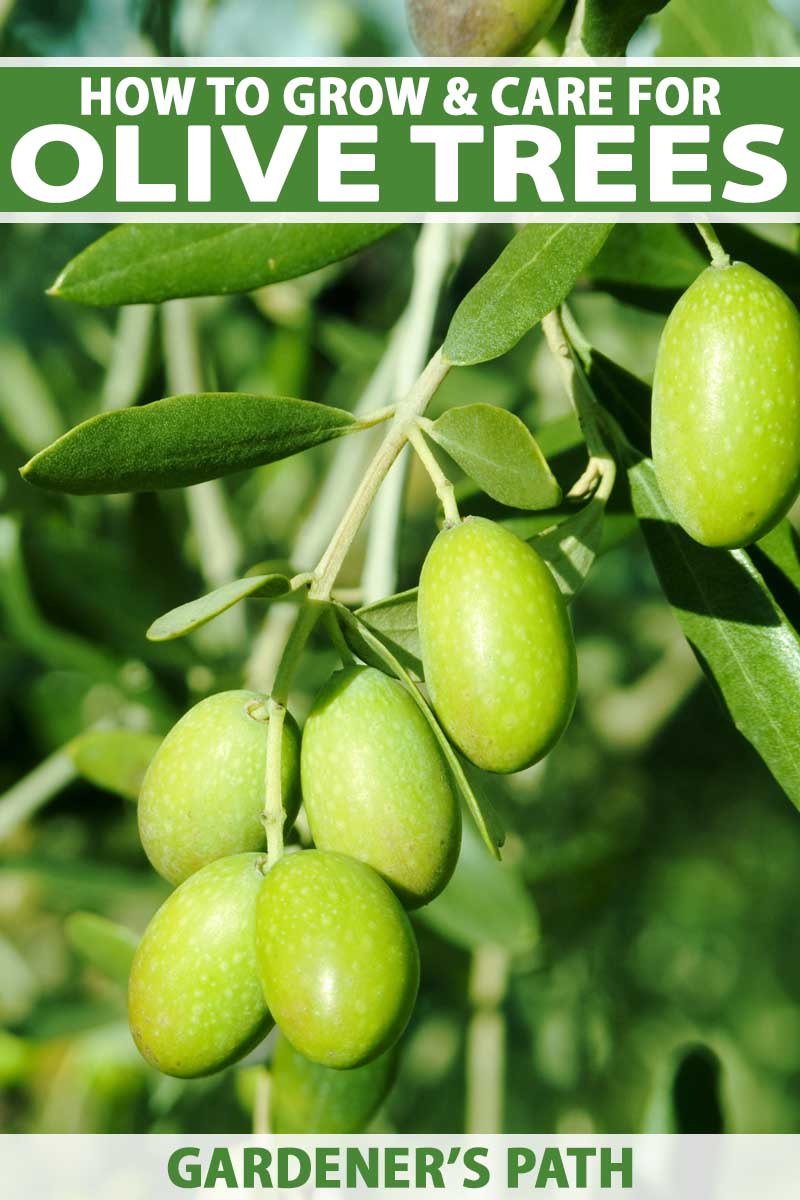
We link to vendors to help you find relevant products. If you buy from one of our links, we may earn a commission.
At around 17°F, you’ll see leaf and small stem damage, and the tree will likely be killed to the ground at temperatures below 10°F, although mature trees may regrow from the roots.
Anyway, are you settled in your new home, or already based in an ideal location? Good!
In this growing guide, we’ll learn more about this Mediterranean import that gifts its caretakers with fabulous fruit, healthful oils, and an attractive addition to the landscape.
Here’s what’s covered in this article:
How to Grow Olives
- What You’ll See When You Survey Your Orchard
- Which Type Is Right for You? (And Where to Buy)
- No Additives, Please
- Prune for More Fruit
- A Bit More on Fruitlessness
- Pests and Disease
- Young and Bitter
- Preparing Your Olives
- Recipes and Cooking Ideas
- Quick Reference Growing Guide
- The Right Setting, The Right Tree
We’ll share everything you need to know to grow Olea europaea, the tree beloved by ancient Greeks and Romans, and whose fruit has been popularized in the modern age by Italians, Greeks, and Spaniards.
What You’ll See When You Survey Your Orchard
Olive trees are evergreen and can grow to 25 to 30 feet tall, with a spread just as wide. Their oblong leaves are silverish and grow from branches emanating from a gnarled, twisted trunk.
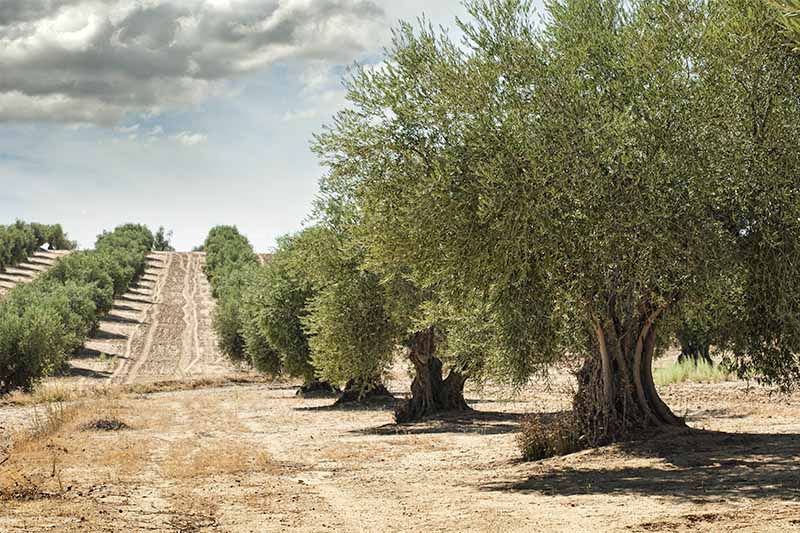
Some experts believe that more space between trees – about 16 to 20 feet – will yield better fruit production. If this isn’t practical for your new parcel of land, consider a dwarf variety, which we’ll discuss in a bit.
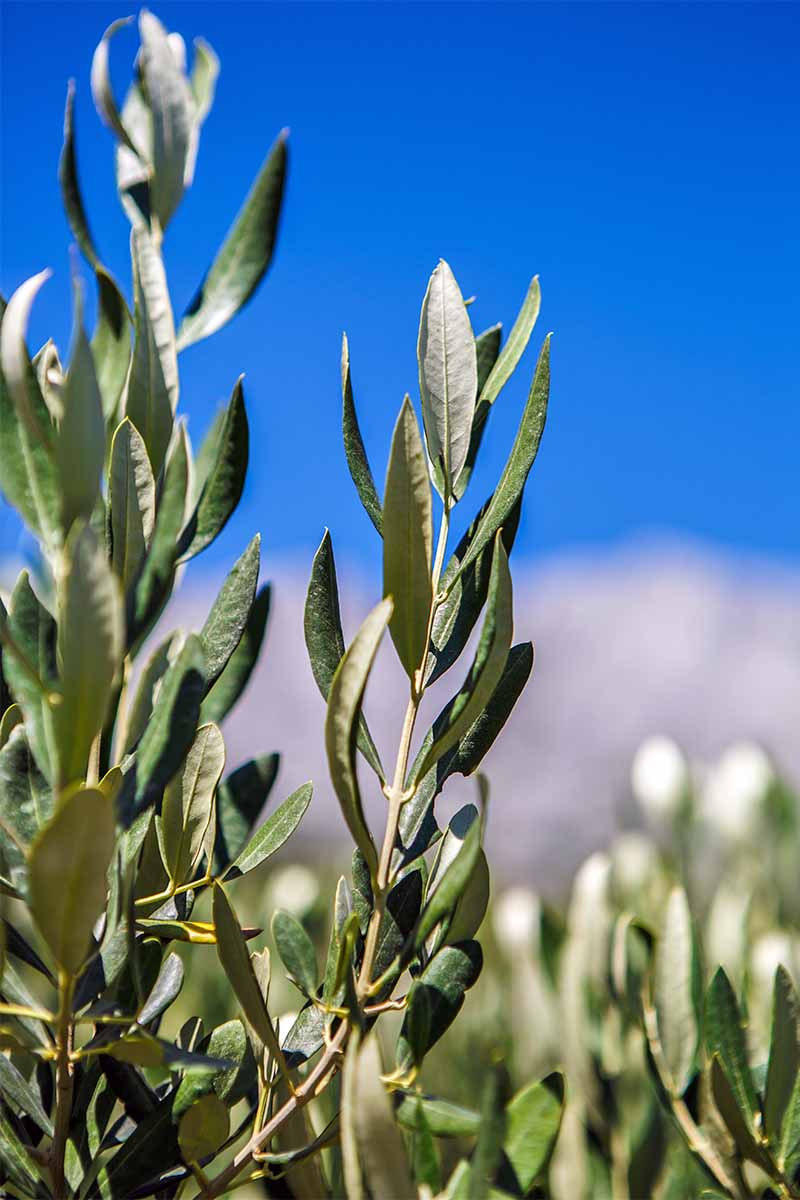
Mind you, if an expansive orchard isn’t at all what you were after, you should know that the olive makes a fine specimen tree that you can plant and enjoy simply for its beauty, with nary a thought to harvest and curing and pressing and whatnot.
Which Type Is Right for You? (And Where to Buy)
The type of tree you select will depend on what you hope to get out of it. Different cultivars produce different flavors of olives and oil, of course.
You might sample various oils at a farmers market, for example, to select a variety that appeals to you.
‘Mission’ is a variety well-suited to home gardeners who wish to press or cure their harvest.
You can find one- to two- and two- to three-foot trees available at FastGrowingTrees.com.
‘Arbosana’ is a cultivar that is suited for smaller spaces, growing to be 12 to 15 feet tall with a spread of 12 to 20 feet.
You can find this type at Nature Hills Nursery.
This Spanish native produces large crops of small fruit with a high oil content that are very flavorful. You’ll receive a tree in a 2.3- to 3.7-quart container.
Most cultivars are self-pollinating, though some are not.
Furthermore, some self-pollinating varieties produce heavier yields when a pollinator – such as ‘Pendolino,’ ‘Maurino,’ or ‘Leccino’ – is growing nearby.
No Additives, Please
As we mentioned above, O. europaea is native to regions that have mild, rainy winters and hot, dry summers.
You’ll want to place your trees where they’ll receive full sun all day.
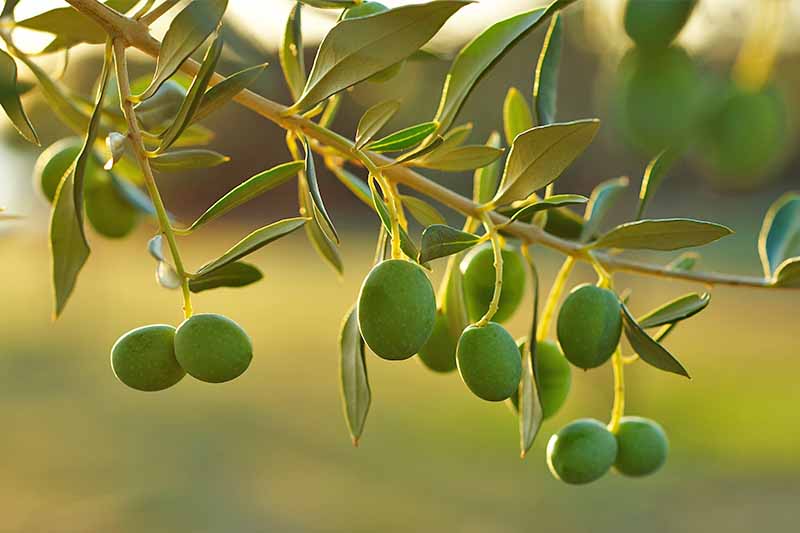
These trees are tolerant of a wide variety of soils, including those with somewhat high clay content, as long as there is good drainage.
Planting a young tree in the fall gives it a chance to become well-established. But this is an option only if temperatures in your area won’t drop below 30°F, or if you can protect the tree.
This is because container-grown trees are susceptible to frost damage during their first winter outdoors.
If waiting until spring seems more prudent, hold off until all danger of frost is past. Planting in the heat of summer is not recommended.

Dig a hole about the same size as the container, and about an inch shallower. Water the tree thoroughly, remove it from its container, and untwist or cut any circling roots.
Set the root ball in the hole. Use soil you removed from the hole to build up about an inch of soil on top of the root ball, and grade down from the trunk to the surrounding soil.
Don’t add compost or other soil additives; the plant has to learn to love the native soil. But do top the planting area with mulch.
Prune for More Fruit
Water young trees two or three times a week during their first summer. Give them a good four inches of water at each watering, and hydrate again when the soil dries out.
Once established, they need little supplemental water.
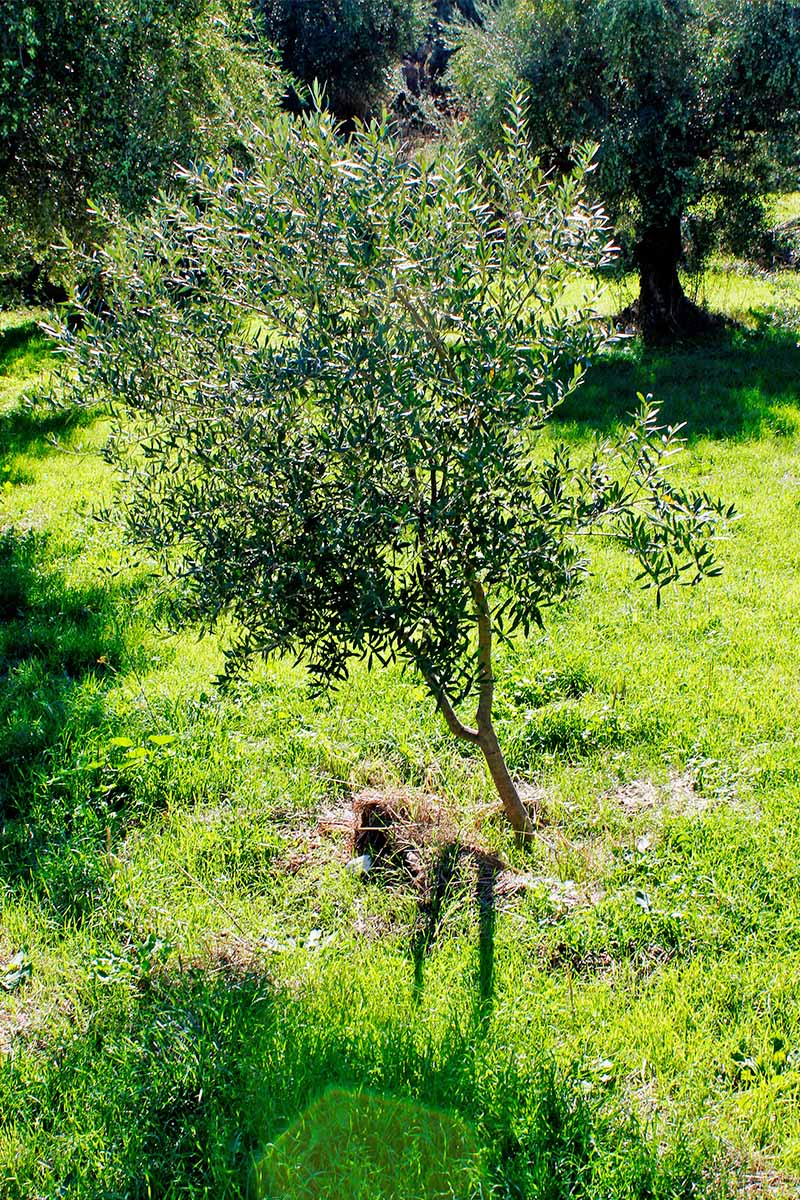
Keep weeds removed from within at least a three-foot diameter of the young tree.
Fertilize newly planted trees in the spring, after new growth begins. They only need a small amount of nitrogen, which can be delivered via compost, as well as conventional or organic fertilizers.
In its first four years, prune the tree only as needed to maintain its shape.
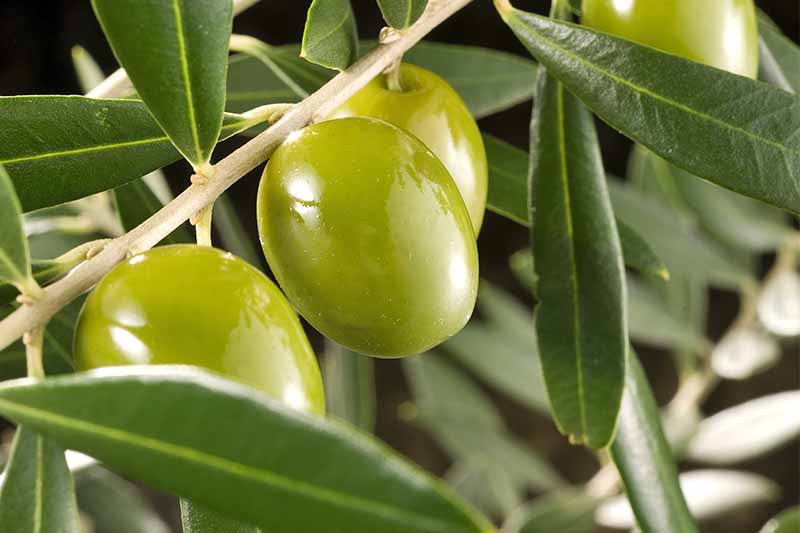
As your tree matures and begins fruiting, you’ll discover an olive oddity: they never bear fruit in the same place on a stem, so new growth each year is necessary for flower production and fruiting.
Starting in the fifth year of growth, you’ll want to prune not only to increase airflow and maintain height or form, but also with future fruiting needs in mind.
A Bit More on Fruitlessness
If you’d rather not have an established tree set fruit, you can apply a plant growth regulator, or use a strong spray from the hose to blast off blooms.
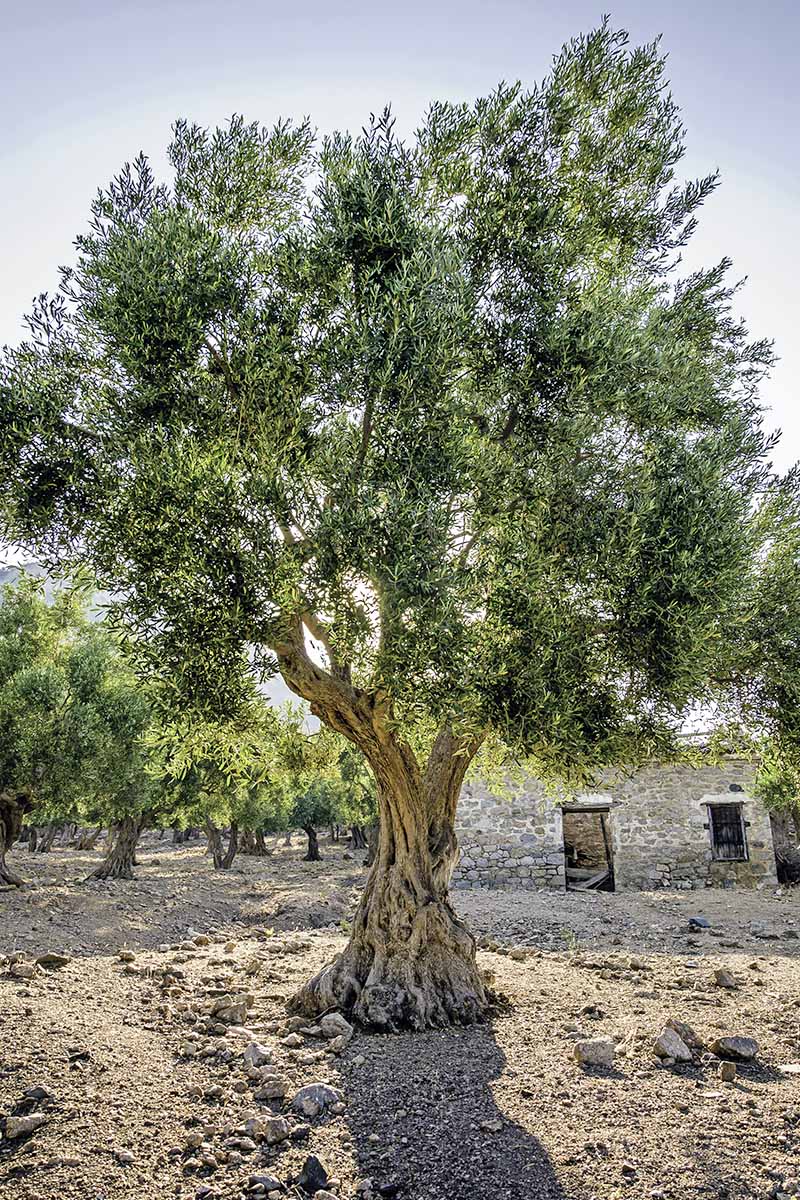
Some gardeners do this only to areas of a tree that overhang a paved area, in an attempt to reduce the mess from falling fruit.
But, because Mother Nature is persistent and these methods don’t always work, if fruitlessness is truly your goal, you might be better off purchasing a fruitless variety such as the one described above.
Pests and Disease
Olives aren’t plagued by many pests, although scale can be a problem.
You can prune off infected stems, or treat these greedy critters with neem oil, such as this one from Bonide, available from Arbico Organics.
This 32-ounce spray bottle is ready to use.
For twenty years or so, California olive growers have been plagued by the olive fruit fly, which lays its eggs inside the developing fruit, destroying it.
Management of fruit flies is difficult, and best achieved via clean gardening practices. Some home gardeners have had luck with fly traps, such as these from Terro, available via Amazon.

TERRO Fruit Fly Trap (Pack of 3)
Trees can also be affected by olive anthracnose, a fungal disease. Treat this problem with a fungicide, such as this one from Garden Safe, available via Amazon.

This 32-ounce spray bottle is ready to use.
Young and Bitter
If you’ve provided your olive tree with a happy home, it will begin to bear fruit when it’s around five years old.
Bear in mind, however, that it’s perfectly normal for olive trees to produce fruit only every other year, or to produce alternating heavy and light crops from year to year.
When you harvest your olives depends on what you intend to do with them, and what flavor you seek.
All olives start out green before turning a purplish color, and then deepening to black. The younger the olive, the more bitter it will be.

Typically, olives are harvested at their green stage if their intended use is for the table, although some varieties are best when black.
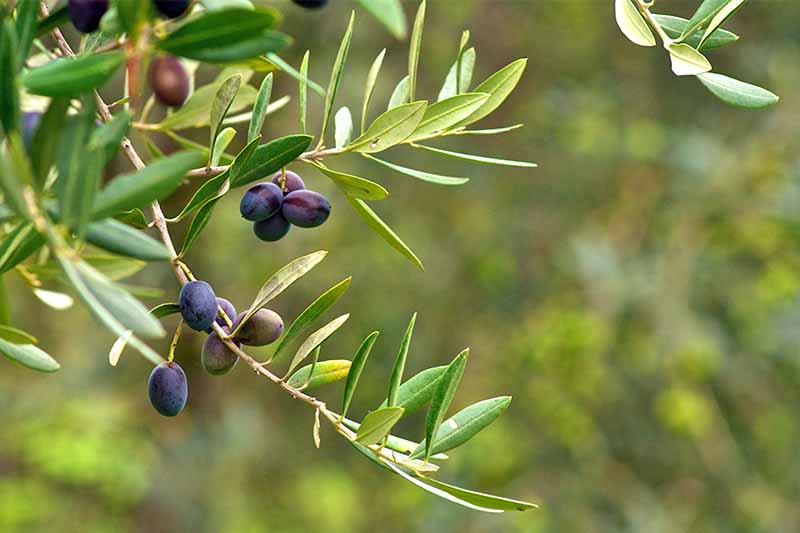
If a pressing is in the cards, the fruit is at its oiliest when it’s in its purple stage.
Olives must be processed – more on this in just a minute – within three days of harvest.

You can either handpick the fruit from your tree, which is quite time-consuming, or you can place a tarp under the tree, and shake the limbs with a rake or other garden implement to dislodge the fruit onto to the tarp for easy pickup.
Preparing Your Olives
Raw olives are not tasty. They must be cured to dispel their inherent bitterness, which is caused by the chemical compound called “oleuropein.”
Inventive humans have developed a number of ways to banish the bitterness from these otherwise tasty little ovals, curing them in oil, water, brine, lye, or simply salt.
None of these methods is particularly difficult, but the olives do have to marinate in your chosen mixture for several weeks – so don’t plan for an appetizer spread complete with homemade tapenade immediately after harvest!
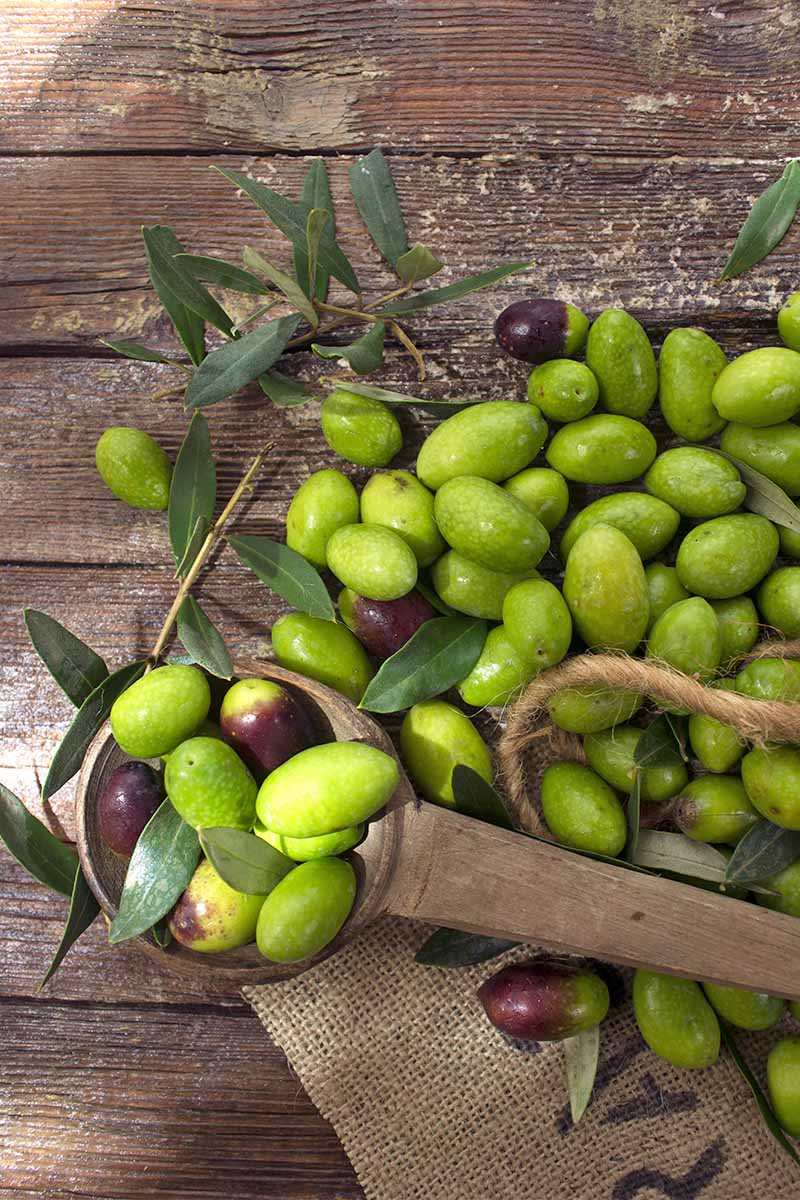
If it’s oil you’re after, you’ll find as many extraction methods as there are days in a month.
At its most basic, the process entails:
- Cleaning
- Mashing
- Squeezing the mash to extract juice
- Separating the oil from non-oil liquid and particulate matter
It can take anywhere from 40 to 90 pounds of drupes to make one gallon of oil. A mature tree will produce between 30 to 100 pounds per season, though the giant ‘Chemlali’ may produce close to a ton per year.
Recipes and Cooking Ideas
You’ve planted, harvested, brined, and pressed. It’s time to savor the fruits of your labor! We don’t have to tell you that a galaxy of recipes await the olive-laden, but we’ll share just a few to get you started.
Begin your meal with a classic Greek salad like this one, from our sister site, Foodal. Made with homegrown cucumber, bell pepper, tomato, red onion, basil, oregano, and parsley, this is truly a garden-fresh delight!
For removing those pits, explore Foodal’s guide to the best cherry and olive pitters.
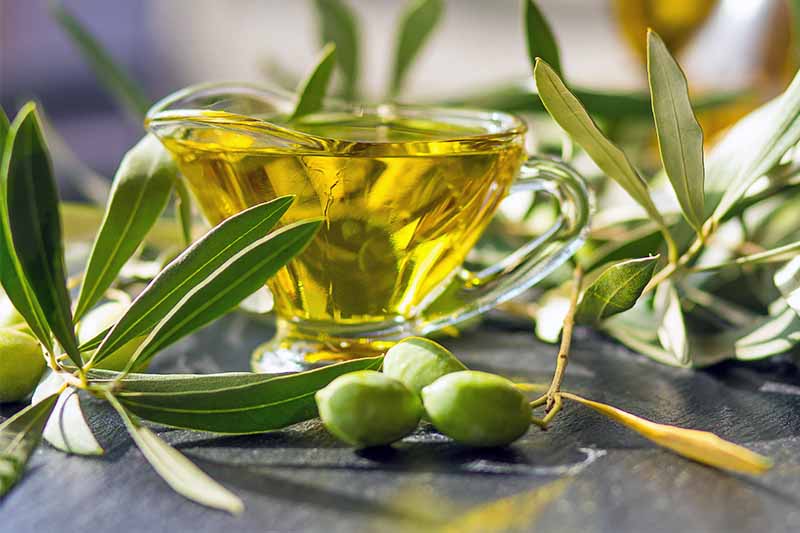
If you’re looking for picnic fare or a light meal, try a Sicilian pasta salad with zucchini, green beans, and marinated artichokes. You’ll find the recipe for this one on Foodal as well.
From Vintage Kitty comes this delightful recipe for an asparagus salad, which features a lemon and light olive oil vinaigrette.
And while we’re on the subject of lemon-olive pairings, consider this chicken recipe from Sugar Love Spices. This rustic delight evokes the Italian countryside.
And for dessert, how about a citrus olive oil cake, also from Sugar Love Spices? This confection utilizes a full cup of extra virgin oil, as well as a variety of citrus juices.
Quick Reference Growing Guide
| Plant Type: | Small, evergreen tree or shrub | Attracts: | Bees and other pollinators |
| Native to: | Mediterranean, Asia, and Africa | Tolerance: | Drought |
| Hardiness (USDA Zone): | 8-11 | Maintenance: | Low |
| Season: | Fruits ripen are ready from August through November depending on cultivar, desired ripeness, and location | Soil Type: | Various loamy soils including sandy loam, clay loam, silt loam, and silty clay loam |
| Exposure: | Full sun | Soil pH: | 7-8 |
| Time to Maturity: | 3-12 years depending on cultivar; most around years 5-6 | Soil Drainage: | Well-draining |
| Spacing: | Minimum of 12 feet between trees in an orchard environment; 6 feet for hedge type planting | Companion Planting: | Other Mediterranean plants including thyme, lavender, oregano, various grasses, and bulbs |
| Planting Depth: | Same as nursery pot, or set crown of bare root stock just below the soil surface | Family: | Oleaceae |
| Height: | 25-30 feet tall at maturity | Genus: | Olea |
| Water Needs: | Moderate; usually irrigated in commercial plantings | Species:: | europaea |
| Common Pests: | Fruit flies, aphids, olive moths, black scale | Common Disease: | Olive anthracnose, olive tree Xylella (quick decline), leaf scorch |
The Right Setting, The Right Tree
So, what are you thinking? Is it time to add an olive tree to fill that blank spot in the backyard?
Pick the variety that fits, water it heavily until it’s established, watch out for olive fruit flies, and soon you’ll be sharing your homegrown olive products with friends and family.

Do you have an olive tree? Which variety? Tell us about your adventures with O. europaea in the comments section below.
And if you decide a different fruit tree of the pitted variety is in your landscape plans, read these guides next:
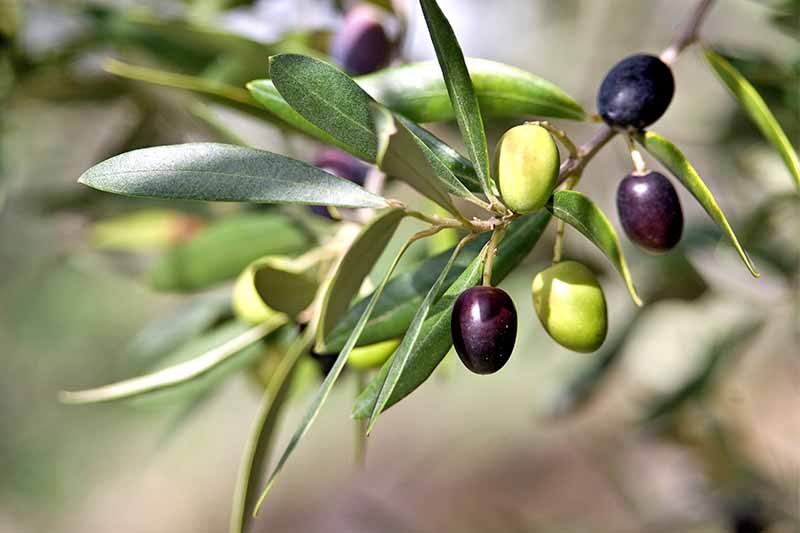
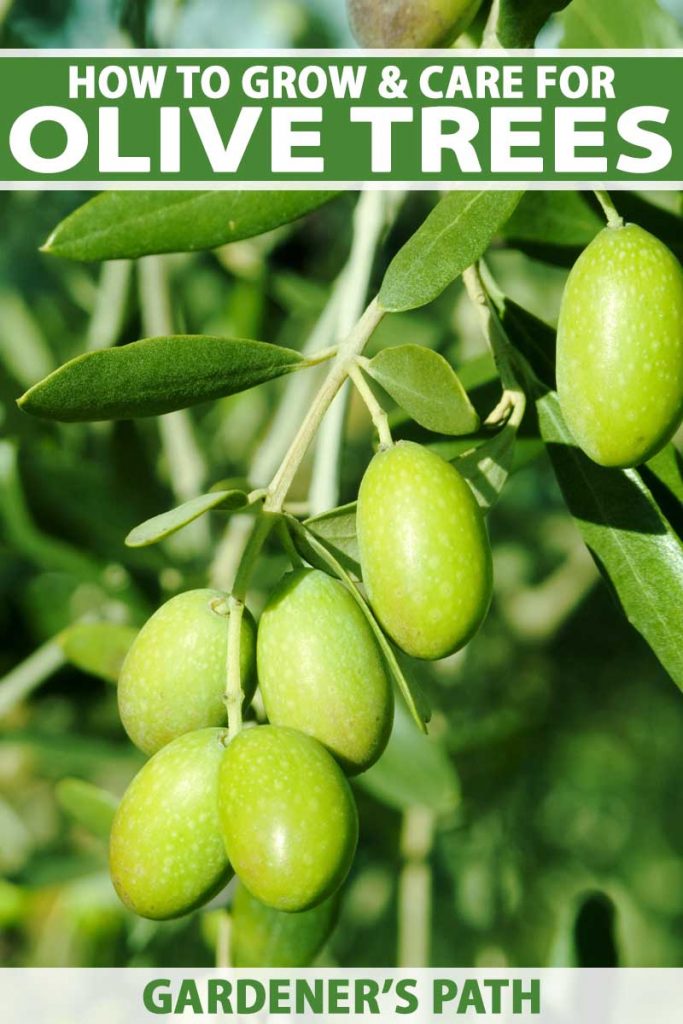
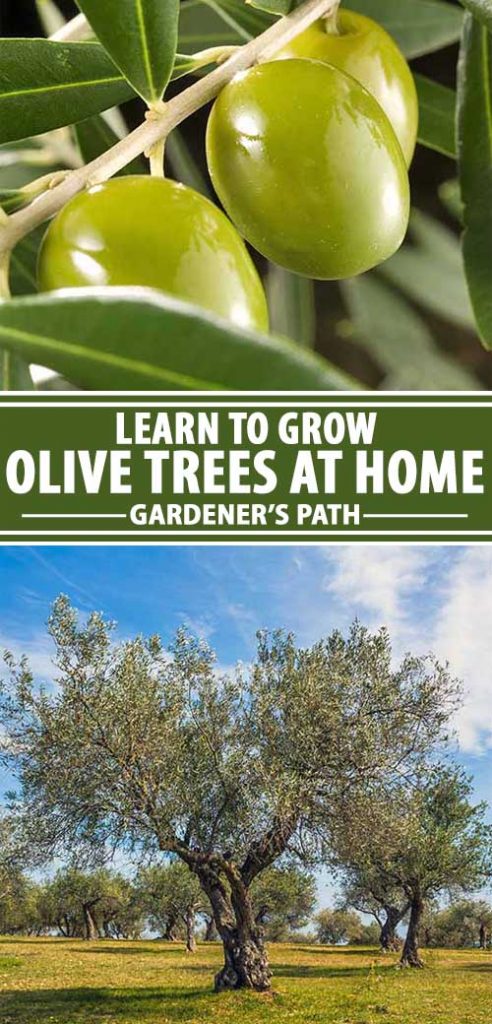
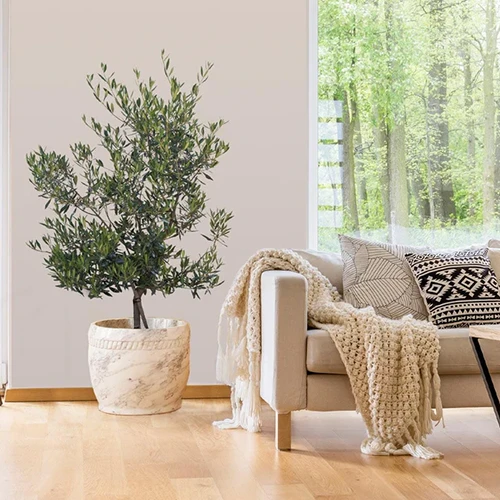
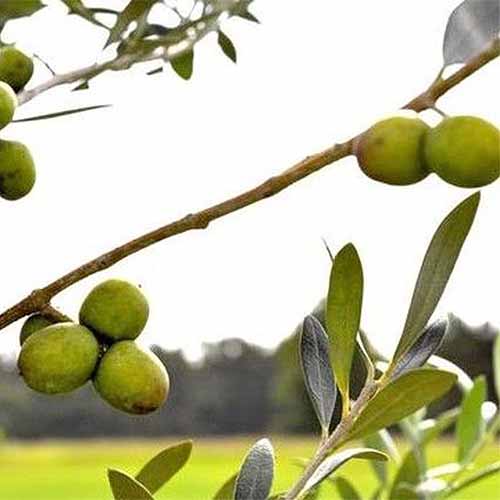
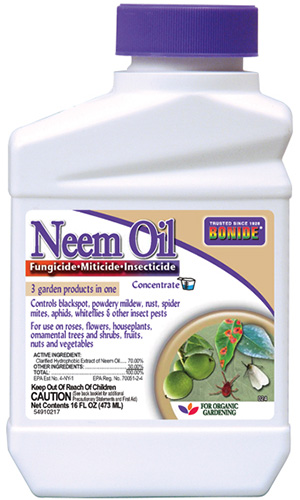
My grandparents had an olive orchard that now passed to my mother and father. It stands beautifully up on a hill in the Italian countryside. That is why olives for me are very important. This is a beautiful post with gorgeous pictures and very informative. Thanks for including two recipes that I love!
I just planted 2 arberquina olive trees in South Florida. It might not be cold enough for long enough time down here. They were on clearance at Lowes. 2 trees for $20. So not a big investment. One is 4 ft tall other is about 2ft tall. I’m getting new growth on them already, planted 3 weeks ago. Time will tell.
Keep us posted, Don!
Same time frame planted growing fast 7 feet…
Very valuable info. If possible, just 1 question. When do the leaves appear for the first time on an olive tree? In three weeks, one month or two?
Hello…. thanks for reading! An olive seed takes about 40 days or so to germinate.
This is Kenneth in Boise ID. I’m finding that it’s too cold to plant an olive tree in Southern Idaho. Would a greenhouse or covering the tree in the winter months be a solution to having an olive tree until it ages enough to withstand 0° temperatures?
Hi Kenneth — so happy you’ve found us here at Gardener’s Path. You’re right; Boise is too cold for an olive tree. No way it could take 0° temps. I think you’re best off finding a tree that’s better suited for your climate — apple maybe? Check out our apple tree growing guide here.
Great post!
Thank you, Patricia! Do you grow olive trees?
I recently purchased 4 olive trees for my grandfather from a local olive orchard. We’re located in central Florida just north of the Tampa Bay area. When would you recommend that I plant them? They are all about 2to3ft tall. We have picked out a suitable location for them. Also was wondering how far I should space them. I purchased the following varieties; Mission, Picual, Manzanilla, and Arbequina. Thanks in advance for any tips or advice.
What a lovely gesture for your grandfather, Matt. He’s a lucky guy. You should be able to plant them now. Fall is a great time to plant trees, and I don’t think you’re expecting a frost any time soon, right?
Planted olive tree
In back yard. It was potted for the last year.
Nice article. I planted 2 arbequinas here (NC outer banks) 3 years ago and they are doing well. We even had an extended period of sub-20 degrees 2 years ago and they came through with no damage. We are 100 yards from the ocean, on sand, and they seem to do fine in all sorts of extremes. Last year we had fruit – maybe 100 olives – but brined they were delicious. This year both trees, now 6-7 ft tall, are covered in blossoms. As far as we know, we have the only olive trees in the outer banks.
I just planted 2 Arbequina olive trees in massive pots near my pool. They were purchased in 5 gallon nursery buckets. We do get pretty decent winds here in the Dallas area. As you can see for my pic, I have braced the tree(s) with string and a heavy weight. I also have large rocks inside the pots near the trunk. Do you think they’ll thrive in pots? Will I have to eventually transplant them into the ground? I planned on pruning them so I could try to keep them in the pots. Thank you for any insight.
Thanks for your questions, Karin. Olives can do well in containers! For awhile, at least. You’ll need to ensure that they have well-draining soil with sufficient drainage holes in the pots – olives don’t like wet feet. You can continue transplanting to larger pots every 2-3 years or so, gradually increasing the pot size. From what we’ve heard, some gardeners have done this successfully for a decade or more! But keep in mind that transplanting will tend to become increasingly difficult as these trees continue to grow. This was a good choice of cultivar, as ‘Arbequina’ tends to grow to… Read more »
I bought a mission olive last year at Trader Joe’s. No surprise, they sold out really fast! I live in Vancouver Washington, 8b on the agricultural climate scale. It’s now about 2 feet tall, and is covered in blooms, or rather buds. Currently it’s in a one gallon pot. When I repot it, can I plant it in a giant pot for it to grow into, or is it better to up-pot to slightly bigger pots until it can fit the big pot…? I’m thinking we’re not quite warm enough here to plant outside – what are your thoughts?
Hi! First I’m going to answer your question about planting your olive tree outside, and then I’ll get to the repotting question. Are you set on getting it to produce fruit again or are you ok with having it just be an ornamental? If you’re ok with it growing as an ornamental, you may want to keep it in a container. On the other hand, if you want to try to get it to produce fruit, you’ll have a better chance of this outdoors where the tree will get both the heat and the chill it needs to produce fruit… Read more »
Thank you Kristina for this great reply! Super helpful! I live in Portland, OR (right across the river from Vancouver, WA) and just bought an Aberquina olive tree to put in a container and was looking for more specifics on my area. You shed some light on many of my questions! I am now thinking that maybe I should plan to put it in the ground in a couple of years… we shall see!
Thanks again for all the information!